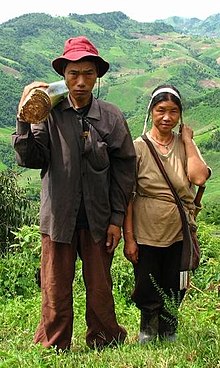 Global Information
Global InformationHuman information
| Human[1] Temporal range: Chibanian – present
| |
|---|---|

| |
| Male (left) and female (right) adult humans, Thailand, 2007 | |
| Scientific classification | |
| Domain: | Eukaryota |
| Kingdom: | Animalia |
| Phylum: | Chordata |
| Class: | Mammalia |
| Order: | Primates |
| Suborder: | Haplorhini |
| Infraorder: | Simiiformes |
| Family: | Hominidae |
| Subfamily: | Homininae |
| Tribe: | Hominini |
| Genus: | Homo |
| Species: | H. sapiens
|
| Binomial name | |
| Homo sapiens Linnaeus, 1758
| |

| |
| Homo sapiens population density (2005) | |
Humans (Homo sapiens) or modern humans are the most common and widespread species of primate, and the last surviving species of the genus Homo. They are great apes characterized by their hairlessness, bipedalism, and high intelligence. Humans have large brains, enabling more advanced cognitive skills that enable them to thrive and adapt in varied environments, develop highly complex tools, and form complex social structures and civilizations. Humans are highly social, with individual humans tending to belong to a multi-layered network of cooperating, distinct, or even competing social groups – from families and peer groups to corporations and political states. As such, social interactions between humans have established a wide variety of values, social norms, languages, and traditions (collectively termed institutions), each of which bolsters human society. Humans are also highly curious: the desire to understand and influence phenomena has motivated humanity's development of science, technology, philosophy, mythology, religion, and other frameworks of knowledge; humans also study themselves through such domains as anthropology, social science, history, psychology, and medicine. As of April 2024, there are estimated to be more than 8 billion humans alive.
Although some scientists equate the term "humans" with all members of the genus Homo, in common usage it generally refers to Homo sapiens, the only extant member. All other members of the genus Homo, which are now extinct, are known as archaic humans, and the term "modern human" is used to distinguish Homo sapiens from archaic humans. Anatomically modern humans emerged around 300,000 years ago in Africa, evolving from Homo heidelbergensis or a similar species. Migrating out of Africa, they gradually replaced and interbred with local populations of archaic humans. Multiple hypotheses for the extinction of archaic human species such as Neanderthals include competition, violence, interbreeding with Homo sapiens, or inability to adapt to climate change.
For most of their history, humans were nomadic hunter-gatherers. Humans began exhibiting behavioral modernity about 160,000–60,000 years ago. The Neolithic Revolution, which began in Southwest Asia around 13,000 years ago (and separately in a few other places), saw the emergence of agriculture and permanent human settlement; in turn, this led to the development of civilization and kickstarted a period of continuous (and ongoing) population growth and rapid technological change. Since then, a number of civilizations have risen and fallen, while a number of sociocultural and technological developments have resulted in significant changes to the human lifestyle.
Genes and the environment influence human biological variation in visible characteristics, physiology, disease susceptibility, mental abilities, body size, and life span. Though humans vary in many traits (such as genetic predispositions and physical features), humans are among the least genetically diverse primates. Any two humans are at least 99% genetically similar. Humans are sexually dimorphic: generally, males have greater body strength and females have a higher body fat percentage. At puberty, humans develop secondary sex characteristics. Females are capable of pregnancy, usually between puberty, at around 12 years old, and menopause, around the age of 50.
Humans are omnivorous, capable of consuming a wide variety of plant and animal material, and have used fire and other forms of heat to prepare and cook food since the time of Homo erectus. Humans can survive for up to eight weeks without food and several days without water. Humans are generally diurnal, sleeping on average seven to nine hours per day. Childbirth is dangerous, with a high risk of complications and death. Often, both the mother and the father provide care for their children, who are helpless at birth.
Humans have a large, highly developed, and complex prefrontal cortex, the region of the brain associated with higher cognition. Humans are highly intelligent and capable of episodic memory; they have flexible facial expressions, self-awareness, and a theory of mind. The human mind is capable of introspection, private thought, imagination, volition, and forming views on existence. This has allowed great technological advancements and complex tool development through complex reasoning and the transmission of knowledge to subsequent generations through language.
- ^ Groves CP (2005). Wilson DE, Reeder DM (eds.). Mammal Species of the World: A Taxonomic and Geographic Reference (3rd ed.). Baltimore: Johns Hopkins University Press. ISBN 0-801-88221-4. OCLC 62265494.